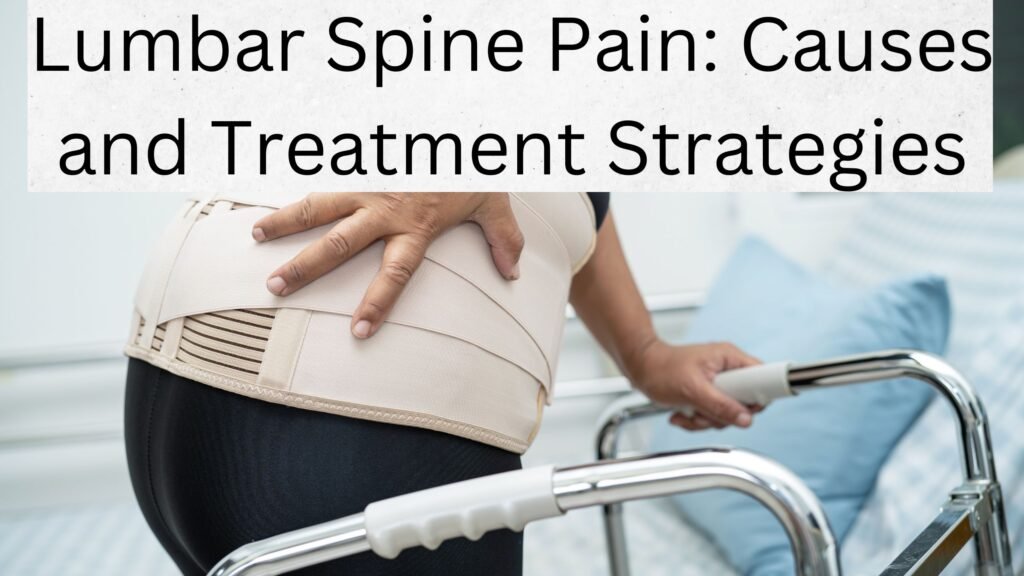Lower back pain is one of the most common health complaints worldwide. The lumbar spine, which consists of five vertebrae in the lower back, supports body weight and enables movement. When this area experiences pain, it can interfere with daily activities and reduce quality of life. Understanding the causes and treatment options is essential for effective pain management.

Common Causes of Lumbar Spine Pain
1. Muscle Strain and Ligament Sprains
Overuse, sudden movements, or lifting heavy objects improperly can strain the muscles and ligaments in the lower back. This often results in stiffness, muscle spasms, and limited mobility.
2. Herniated or Bulging Discs
The discs between the lumbar vertebrae act as cushions. When a disc bulges or ruptures, it can press on nearby nerves, leading to pain, numbness, or weakness in the lower back and legs.
3. Degenerative Disc Disease
As people age, the spinal discs lose hydration and elasticity, causing them to wear down. This degeneration can lead to chronic lower back pain and reduced flexibility.
4. Spinal Stenosis
Narrowing of the spinal canal in the lumbar region can put pressure on the spinal cord and nerves. This condition often causes pain, tingling, and weakness in the lower back and legs, especially when standing or walking.
5. Sciatica
Compression or irritation of the sciatic nerve, which runs from the lower back down the legs, can cause sharp pain, burning sensations, or numbness. Sciatica is commonly linked to herniated discs or spinal stenosis.
6. Arthritis
Osteoarthritis can affect the joints in the lumbar spine, leading to stiffness and pain. Inflammatory conditions like rheumatoid arthritis may also contribute to lower back discomfort.
7. Poor Posture and Sedentary Lifestyle
Sitting for long hours with poor posture can strain the lumbar spine. Weak core muscles and lack of movement contribute to lower back pain over time.
8. Trauma or Injury
Accidents, falls, or sports injuries can damage the lumbar spine, causing fractures, soft tissue damage, or misalignment of the vertebrae.
Effective Treatment Strategies
1. Rest and Activity Modification
Short-term rest can help with acute pain, but prolonged inactivity may weaken muscles and worsen symptoms. Avoid heavy lifting and excessive bending while keeping mild movement to prevent stiffness.
2. Physical Therapy
A structured physical therapy program strengthens core muscles, improves flexibility, and corrects posture. Common exercises include:
- Pelvic tilts to strengthen lower back muscles
- Bridges to improve core stability
- Hamstring stretches to relieve tension in the lower body
3. Pain Management Medications
Over-the-counter pain relievers like ibuprofen or acetaminophen can help reduce inflammation and discomfort. In some cases, doctors may prescribe muscle relaxants or corticosteroid injections for more severe pain.
4. Heat and Cold Therapy
Applying ice packs can reduce swelling and numb acute pain, while heat therapy increases blood flow and relaxes tight muscles. Alternating between heat and ice may provide optimal relief.
5. Chiropractic Care
Chiropractic adjustments help realign the spine and reduce nerve compression. Spinal manipulation may relieve lumbar pain and improve mobility in some individuals.
6. Posture Correction and Ergonomics
Improving posture reduces strain on the lumbar spine. Simple adjustments like sitting with a straight back, using a lumbar support cushion, and keeping feet flat on the floor can help prevent pain. Ergonomic office chairs and standing desks also promote spinal health.
7. Weight Management
Excess weight increases pressure on the lumbar spine, leading to pain and degeneration. A balanced diet and regular exercise help maintain a healthy weight and reduce strain on the lower back.
8. Surgical Intervention
Surgery is typically a last resort when conservative treatments fail. Procedures like discectomy, laminectomy, or spinal fusion may be necessary for severe conditions such as herniated discs or spinal stenosis.
Prevention Tips for Lumbar Spine Pain
1. Maintain a Strong Core
Regular core-strengthening exercises support the lower back and improve stability. Planks, bridges, and abdominal exercises help prevent strain.
2. Practice Proper Lifting Techniques
When lifting objects, bend at the knees, keep the back straight, and hold the load close to the body to avoid unnecessary stress on the spine.
3. Stay Active
Incorporating low-impact activities like walking, swimming, or yoga into a daily routine keeps the spine flexible and reduces stiffness.
4. Adjust Sleep Position
Sleeping on the back with a pillow under the knees or on the side with a pillow between the knees supports spinal alignment and reduces pressure on the lumbar region.
5. Reduce Stress
Chronic stress can lead to muscle tension and increased pain. Relaxation techniques like deep breathing, meditation, and massage therapy can help manage stress levels.
When to See a Doctor
If lumbar spine pain persists for more than a few weeks, worsens over time, or is accompanied by numbness, weakness, or loss of bladder control, seek medical attention. Early diagnosis and treatment prevent complications and improve recovery outcomes.
Conclusion
Lumbar spine pain can arise from various causes, including muscle strain, herniated discs, and degenerative conditions. Identifying the root cause and using a combination of treatments—such as physical therapy, pain management, and posture correction—can effectively reduce discomfort. By taking preventive measures and maintaining a healthy lifestyle, it is possible to minimize the risk of lower back pain and improve overall spinal health.